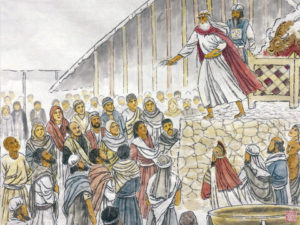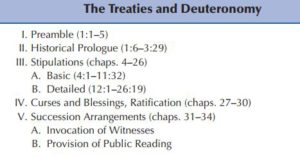
“You are standing today, all of you, before the LORD your God…so that you may enter into the sworn covenant of the LORD your God, which the LORD your God is making with you today, that he may establish you today as his people, and that he may be your God, as he promised you, and as he swore to your fathers, to Abraham, to Isaac, and to Jacob.” Deut. 29:10,13
A number of scholars have argued convincingly that there is a relationship in form between the Hebrew covenant and the ancient Near Eastern vassal treaty…
In its classical form, the Near Eastern vassal treaty has the following component parts:
1. Preamble (“These are the words . . .”).
2. Historical Prologue (“antecedent history,” i.e., events leading to and forming the basis of the treaty).
3. General Stipulations (statement of substance concerning the future relationship, which (1) is intimately related to the antecedent history, and (2) summarizes the purpose of the specific stipulations).
4. Specific Stipulations.
5. Divine Witnesses: various deities are called to witness the treaty.
6. Blessings and Curses: relating respectively to the maintenance or breach of the covenant.
There are in addition a number of other sections in certain texts which deal with the deposition of the treaty, its public reading, ceremonies of oath, and various formal procedures…The vassal treaty was employed within the Near East when a great power (the suzerain king) imposed certain conditions of vassaldom on a smaller state (the vassal), which would normally have been conquered by the more powerful state in battle. The treaty explained the reasons for imposition and the nature of the conditions imposed on the smaller state, and made certain provisions relating to the maintenance of the treaty. The same basic type of treaty seems to have been employed throughout the Near East, and there is evidence of its use, in simpler form, in Mesopotamia as early as the third millennium. In Egypt, there is some evidence to suggest that the treaty form was employed not only in relation to external vassal states, but also in relation to foreign (labor) groups within Egypt…
The Hebrews adapted the treaty form for their own use in order to express the nature of their relationship to God. For many years they were in effect vassals to Egypt, but that old bondage was brought to an end in the Exodus from Egypt. Being liberated from bondage to an earthly power, they then submitted themselves in the Sinai Covenant to become vassals of God, the one who had liberated them from Egypt. The nature of this new submission, expressed in the covenant, finds its dramatic expression through the utilization and adaptation of the treaty form. While other small states might serve Egypt or the Hittite Empire as vassals, the Israelites owed their allegiance only to their suzerain God. This treaty form, in which their covenant was set, finds striking expression in the book of Deuteronomy as a whole; in broad outline, the treaty form of the book may be described as follows:
1. Preamble (Deut. 1:1-5); “These are the words which Moses addressed to all
Israel. . . .”
2. Historical Prologue (Deut. 1:6–4:49).
3. General Stipulations (chs. 5–11).
4. Specific Stipulations (chs. 12–26).
5. Blessings and Curses (chs. 27–28).
6. Witnesses (see Deut. 30:19; 31:19; 32:1-43).
The last two points can be expressed more broadly to encompass the whole work: (5) chs. 27-30, curses and blessings, with exhortation; (6) provisions for the continuity of covenant and a successor for Moses.
This overall structure of the book of Deuteronomy suggests that it can be regarded essentially as a unity. The relation of chap. 33-34 to the rest of the book is doubtful, but they may also be integral to the whole…The book is thus a literary account of the renewal of the covenant with God on the plains of Moab. The literary (treaty) pattern may be more than merely a literary device; it is probable that it reflects also the ceremony during which the covenant was renewed and a successor to Moses was appointed. The apparently unified composition of the book has certain implications for questions relating to date and authorship; while the treaty pattern underlying the structure of Deuteronomy does not automatically solve those questions, it does reduce to some extent the number of answers that are viable…
[Against critical scholars who advance the theory that Deuteronomy is a late work [~ 700 B.C.], Kenneth Kitchen has presented four significant differences [between early treaties in the second millennium BC and the late first millennium BC]. (1) In the early treaties, the divine witnesses almost always are placed between the stipulations and curses; they do not occur in this position in the extant first-millennium treaties. (2) The matter of the historical prologue—see above. (3) The blessings in the second-millennium treaty are a regular balance to the curses; the curses in the later texts do not have corresponding blessings. (4) There is a more consistent order to the elements of the early treaties than appears in the first-millennium BC treaties…
[In short, form and structure of the Book of Deuteronomy suggest that it is likely to have originated in the time of Moses rather than in the time of the late monarchies of the kingdom of Israel].
———————–
Deuteronomy as Covenant Treaty

Kline argued that the treaty relationship between a conquering king and a subject people was the paradigm used to define the relationship between God as suzerain lord and his vassal people Israel. The parties were identified in the treaty preamble. In the second millennium treaties, this was followed by a historical prologue in which the past relationship between the suzerain and the vassal was recounted, emphasizing the beneficence of the king to his servant. The stipulations contained the detailed laws agreed to by the vassal in his submission to the suzerain. The most prominent demand was for the exclusive allegiance of the vassal to his covenant lord. The stipulations ordinarily included provisions for the tribute the vassal was to bring to his lord. In the context of Israel’s relationship with Yahweh, this tribute consisted in part of the required offerings and sacrifices specified in the cultic laws. The second-millennium treaties then included a lengthy list of blessings and cursings that would follow obedience or disobedience to the covenant stipulations. These blessings and cursings were invoked in the names of the gods of both suzerain and vassal; the gods were invoked as witnesses to the oaths accompanying ratification.
In God’s covenant with Israel there could be no thought of invoking third-party deities to witness the ratification of the covenant; instead, “the heavens and the earth” are called to fulfill this function (Deut. 4:26; 30:19; 31:28). The treaties included provisions for future public readings of the covenant document in order to remind both suzerain and vassal of their duties under its provisions (Deut. 31:9–22). The treaties contained provisions for the vassal’s sons to succeed their father (Deut. 31: 1–8). Duplicate copies of the treaty document were made (“two tables of the law”—Exod. 34:1, 28; Deut. 10:1–5; 17:18–19; 31:24–26), one each to be deposited in the respective sanctuaries of the suzerain and vassal. Since this sanctuary was one and the same in the covenant between God and Israel, the tablets were placed in the ark.
Because of its strong affinities with the structure of second-millennium treaties as opposed to the structure of treaties known from the first millennium, Kline’s argument provided a prima facie case for a date for Deuteronomy close to the period of Moses instead of at a later time such as the seventh century. Treaties from the Assyrian period did not contain the historical prologue. Instead of listing both curses and blessings, the Assyrian treaties mentioned only the maledictions to be inflicted on the disobedient vassal. The requirement that a copy of the treaty be deposited in the sanctuary of both suzerain and vassal is not found in the first-millennium documents. In the Hittite treaties the demand that the vassal love (be faithful to) the suzerain is accompanied by assurances of the suzerain’s affection (fidelity), but this is not found in the Assyrian treaties…However, on the whole, Deuteronomy does show clear affinities with extrabiblical treaty documents, and more specifically with those of the second millennium; it is fairly clear that Deuteronomy was well described as a “covenant” (Deut. 29: 9, 12, 14, 21) document.
Sources:
Peter Cragie, Book of Deuteronomy NICOT (Eerdmans, 1976), pp. 22-24.
Tremper Longman & Raymond Dillard, An Introduction to the Old Testament 2nd. (Zondervan, 2006), pp. 110-111.
For More In-depth Reading
Kenneth Kitchen, On the Reliability of the Old Testament (Eerdmans, 2003).
Meredith Kline, Treaty of the Great King: The Covenant Structure of Deuteronomy (Eerdmans, 1963).
Related Post: Reading the Bible as a Covenantal Document
Criticism against the Graf-Wellhausen Documentary Hypothesis (DH) seems to have been decisive enough so that only a handful of critical scholars seriously defend the DH today. Strangely, while critical scholars are unable to answer various criticisms of the DH, they just ignore them and continue their reading the bible with their usual citation of the so-called documentary sources of “J”, “E”, “P”, “D” etc. The same phenomenon can be seen in critical scholarship on so-called multiple authorship of the Book of Isaiah (I heard critical scholars speculating there could be up to seven ‘authors’ of the Book of Isaiah!) Note that the fragmentation of a theory is evidence that it is in trouble, that is when its proponents keep multiplying the so-called background documentary sources.
Talking about confirmation bias and the insinuation that orthodox evangelicals are closed-minded – the foundations of the DH may have been destroyed, but somehow critical scholars managed to continue to live serenely in their free-floating magnificent castle, a testimony to the dead end of historical scholarship premised on the idea that the bible is a product of particular geographical and historical circumstances rather than of divine revelation given through the Moses and the prophets of Israel.